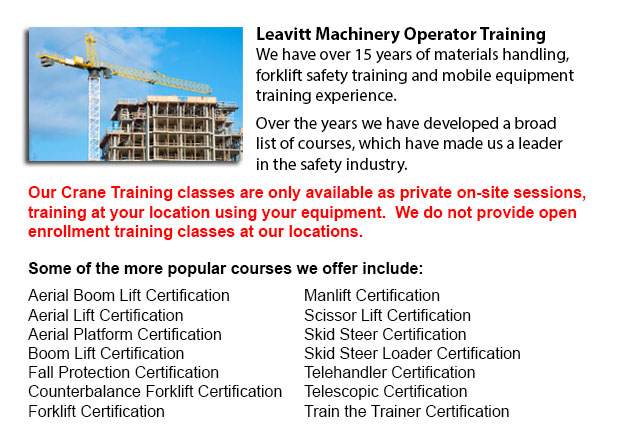
Ontario Crane Certification - The Crane Certification Program consists of the industry recommended subject matter which would teach the safe and efficient operation of cranes. The individual will train in the following: pre-operational, operational and post operating requirements; how to identify cranes and their component parts; rigging components and inspection/rejection criteria; how to determine overall lift capacity; and requirements particular to the work place where the trainees would be working.
Pre-operational requirements include assigning authority for the pre-operational check; performing the sequential pre-operational check based on the manufacturer's specifications or specifications certified by a professional engineer; checking the log book for comments; checking the work area for obstacles and hazards; inspecting cables, hooks, chains safety latches and crane movement; ensuring the right functioning of operational controls; and knowing how to ensure the crane's disconnect switch/isolator is properly functioning.
Operational requirements include identifying responsibilities and roles, and determining the requirement for a formal lift plan. Trainees would know how to perform a danger assessment connected to environmental situations, physical conditions and workers. Subject matter comprises determining when to seek competent help, the destination of loads and the safest route, and load weight and centre of gravity.
It is vital for individuals training to be able to identify an over-capacity lift, pick proper rigging machinery, be aware of load limitations, and determine a safe place from which to operate. Trainees will review both universal and site-specific crane signals for lifts, and methods for lifting, loading and traveling. Proper maintenance practice will be covered.
Trainees will be assessed on their understanding of the need for emergency response procedures for various situations such as a mechanical or electrical failure. They would be asked to describe shut down and parking procedures for security and safety, to follow lock out and tagging procedures, and to explain the reason why near misses are recorded and reported to the right individual. Log book records must be maintained.
People training will develop knowledge of rigging, in particular, establishing who has responsibility and authority for rigging, identifying various kinds of rigging, knowing storage procedures and load capacity ratings.
The requirements after operation of the crane will be taught as well, learning to enter the deficiencies and defects; and to log the history of maintenance and service records, based on the state, provincial and federal codes requirements.
What's more, we incorporate site-specific needs to be able to meet the employers needs into our crane certification training program.
-
Ontario Manlift Certification
Ontario Manlift Certification - The Elevated Platforms and Manlifts Certification course helps to provide the required training on the work practices, safe operating procedures, regulations and rules regarding the everyday activities for the operator... More -
Ontario Crane Training
Ontario Crane Training - Bridge cranes or overhead cranes are actually a type of industrial material handling crane making use of a line and hook mechanism that runs on a horizontal beam running along two widely separated rails. Various overhead cran... More -
Ontario Aerial Lift Train the Trainer
Ontario Aerial Lift Train the Trainer - The Aerial Lifts Train the Trainer Certification Program teaches trainers how to effectively train operators in safe industrial mobile machinery operation. Trainers are given in-depth instruction about aerial l... More -
Ontario Warehouse Forklift Training Classes
Ontario Warehouse Forklift Training Classes - The reason for warehouse training classes are to raise the awareness of common workplace dangers. The trainees will learn essential warehouse safety procedures. An emphasis is placed on paying attention t... More -
Ontario Forklift Training School
Ontario Forklift Training School - Forklift Training School - Industry and federal regulators have established the criteria for forklift safety training based on their current standards and regulations. Those wanting to operate a forklift must finish... More -
Skid Steer Loader Training in Ontario
The engine powered skid-steer loader consists of a rigid and small frame, equipped along with lift arms that could attach to lots of industrial tools and attachments to execute many labor saving jobs. Normally, skid-steer loaders are four-wheel drive... More -
Ontario Crane License
Ontario Crane License - Crane operators ought to be "credentialed", that means they ought to own a crane operator certification or license. Credentialing is considered a mandatory governmental requirement to be able to practice as an operator of a cr... More -
Ontario Forklift Operator Training
Ontario Forklift Operator Training - Forklift training is a prerequisite in North America and is intended to prevent workplace injuries and death. Forklift training offers driver training intended for forklift operators. Training programs teach the s... More

Forklift Certification Ontario
TOLL FREE: 1-888-254-6157
Toronto, Ontario
forkliftcertificationontario.com
Email Us
About Us


